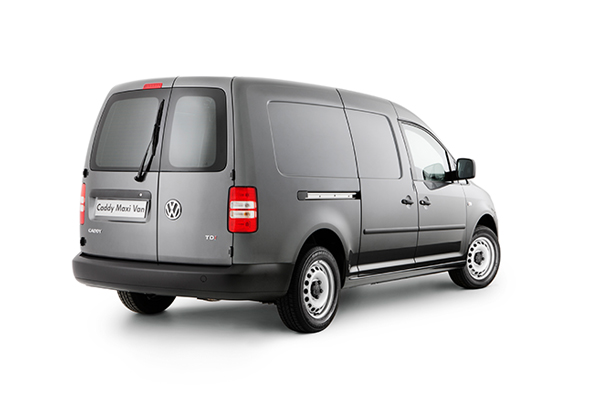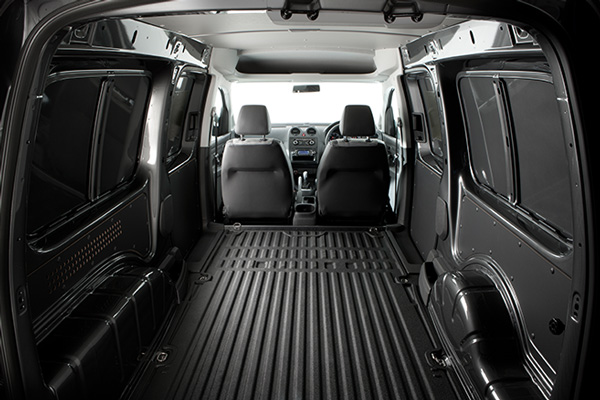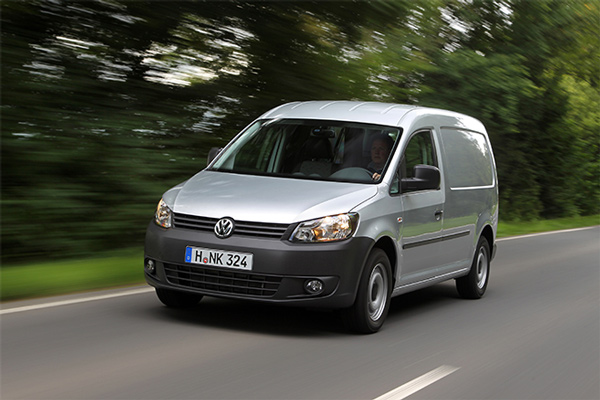Volkswagen is making a play for a bigger slice of the pie with the Volkswagen Caddy Maxi 4MOTION. The latest update to its Caddy small van range is going all-wheel drive. Gary Worrall reports.
Although a relatively late starter to the ‘small van’ market in Australia, Volkswagen actually debuted the first generation Caddy in 1982 in Europe, eventually landing Australia as a ‘third generation’ model in 2005, including the option of a long wheelbase Caddy Maxi version.
The current model arrived in December 2010, continuing the tradition of competent, easy to operate small vans established by the earlier versions, with the announcement of all-wheel drive at the Australian International Motor Show in July 2011.
The Caddy was one of the first van models to introduce the bonneted look now common on virtually all light commercials, offering the benefit of not just improved aerodynamics but increasing occupant crash safety.
The new model continues this trend with a frontal aspect that would be at home on most small passenger cars − a sloping nose cone, wrap-around headlights and indicators, and a deep bumper to help ease airflow around the wheels.
Another advantage of this design is the windscreen lays back to close to 45 degrees, reducing drag and moving the driver’s feet back behind the engine − almost impossible to achieve in ‘forward control’ vans.
From the B-pillar back, there is no doubting the commercial nature of the Caddy’s design, with the long flat roof stretching to the tailgate, which can be exchanged for barn doors, as well as slab sides for maximum cargo volume.
As with the earlier versions, the current Caddy retains the twin sliding doors, so that one-way streets, common in the urban and CBD settings it is likely to be found in, do not stop safe work practices, as the cargo area can be accessed from both sides.
Although alloy wheels can be fitted, most operators would stick with the pressed steel offering, as kerb hopping-induced gravel rash is less obvious on the plain rims.
Engine
Though the two-wheel drive models are offered with a choice of manual and direct shift gearbox (DSG) transmissions, the Caddy 4motion comes as a single mechanical specification – the full-house TDI320 engine, pushing out 103kW and 320Nm of torque from its 2-litre turbo diesel engine, going to ground through a 6-speed dual clutch gearbox.
This is an amazing engine, one of the smoothest small-bore diesels on offer, with a linear torque output that delivers peak torque from 1,500rpm through to 2,500rpm, exactly where a hard-working light commercial needs it.
Despite its willingness to rev, the engine idles smoothly and unobtrusively, with a barely audible hum emanating from under the bonnet. Even at full power, there is no harshness to the engine note, just some inlet ‘roar’ to confirm the engine is working hard.
Transmission
The 6-speed DSG rips through gear changes under acceleration with crisp no-fuss shifts, probably the Caddy’s only weak point, and one common to DSG transmissions – to boost fuel economy, the gearbox goes for the highest possible gear when the throttle is released, so the transition from acceleration to cruising can be harsh while the transmission decides which gear is needed to maintain the road speed.
Similarly, in-gear acceleration can be sluggish initially, while the computer decides if the current gear is up to the task, or whether it should drop back a gear or two for improved pick up.
There is a simple solution: if the driver can see a need for sudden acceleration, select manual control by pushing the T-Bar sideways, and then drop back the required number of gears, and allow the engine torque to do the job.
Best of all, the computer will re-engage a few seconds after the throttle is released, so that fuel economy is maintained, offering drivers the best of both worlds.
Cab and Controls
An advantage of the ‘car-like’ design is the ease of access to the cabin area; just open the doors and slide behind the height and reach adjustable wheel, with plenty of leg-room for all size of drivers.
Despite this, the seats are an ergonomically correct version of the ‘sit up and beg’ position found in most vans, and prove to be remarkably comfortable, the only down side is a lack of lateral support and a slightly narrow seat base for bigger drivers.
This aside, there is plenty of back and shoulder support and the flat floor means with cruise control engaged even a long trip is not exhausting – critical for couriers facing long days with multiple stops.
The seats are covered in a hard wearing cloth material, with a muted colour scheme, there is enough colour to avoid being drab without looking like Liberace’s Love Machine, as well as being easy to clean.
The pedals are spaced far enough apart to prevent accidental operation, but not so far apart the driver is left floundering when switching from stop to go, or vice versa.
Volkswagen has done plenty of work to create simple, fuss-free dash layouts that are easy to use, and the Caddy is no different.
Big clear dials handle the main functions of speedo and tacho, with smaller dials for fuel gauge and engine temperature, while everything else is contained in the multi-function display, all controlled from stalks on the steering column.
These stalks also operate cruise control, windscreen wipers and indicators, while audio and optional telephone controls are found on the face of the steering wheel.
The audio head unit, air-conditioning and ventilation switches are all located in the central dash, still within easy reach of the driver, while the headlights and fog lights run from a rotary dial to the right of the steering wheel.
Views from the driver’s seat are generally good, although the nose drops out of sight it is easy to predict where the corners are to avoid braille parking situations. The only real issue is the thickness of the A-pillar. Thanks to the life-saving airbags they tend to create a blind spot, especially on the left.
This is an issue for most new vans. Without a doubt they are safer for having airbags and crush-resistant pillars. Unfortunately, the trade-off is a loss of peripheral vision, particularly at T-intersections and pedestrian crossings, requiring drivers to be extra-vigilant.
Load
The load area is biggest in class, with the ability to fit a skid between the wheel arches; the barn door option is the only way to go if fork lifts are involved.
The twin sliders mean nothing remains hidden for too long, while the remote central locking ensures everything is still in the Caddy when the driver returns.
Performance
Volkswagen has developed a speed-sensitive electro-mechanical power steering unit, providing a solid feeling while virtually removing ‘dead ahead’ vagueness so that even slight pressure on the wheel gets the front tyres turning for precision control.
This means reverse parking is a breeze. With plenty of low-speed assistance, it is simple to flick the front end around to swing the rear into the desired position.
With the Golf and Tiguan models already featuring a reliable ‘self-parking’ system, the odds are Caddy will receive it as an option. Already, parking sensors can be optioned. It is mainly a case of needing the appropriate software to run the system.
As previously mentioned, the twin sliding doors and tailgate or barn door rear-end mean loading and unloading is simple, the openings are big, allowing operators to fully exploit the 4.2 cubic-metres of space inside the cargo area, in even tight loading bays.
There are also eight pre-fitted load restraint hooks. Given the Caddy is not going to hold ultra-heavy loads, these allow cargo nets or light-duty load-locks to be fitted to make sure boxes do not walk around while in transit.
With Volkswagen Caddy traditionally a front-wheel drive offering, which contributes to the flat floor and overall volume of the cargo area, going AWD was not just a case of fitting an extra couple of axles.
Instead, European specialist Haldex provides an electronically controlled multi-disc clutch, while a rear differential, two-part drive shaft, a redesigned exhaust system, a ‘saddle’ fuel tank over the drive shaft and extra chassis bracing at the rear were also added.
Although the Caddy 4motion does offer AWD, it is not a traditional 4WD, and Volkswagen makes no claims about its rough terrain capability.
Instead, the Haldex system provides extra grip on loose surfaces, such as snow, ice or gravel, that might be beyond the reach of regulation front-drive models. Even the tyres are road-based, without the chunky tread pattern normally offered on bush-bashers.
The good news is the fuel consumption penalty is minor in dry weather operation. Although there are increased grip levels, it is not suggested to emulate the feats of Volkswagen factory rally team, as fragile freight and fast cornering do not mix well.
The end result is the ability to travel further on poor quality roads, or in adverse weather, safely and with confidence in the ability to make it back afterwards, although common sense should always prevail, and the laws of physics do still apply.
With all-wheel disc brakes supported by ESP, ABS, ASR, MSR, EDL and a hill holder, the Caddy is not short on driver support, and pulls up straight and true, while the brakes can withstand multiple heavy applications, before they begin to suffer.
The only real complaint was a lack of suspension travel, it did not take much to have the body riding on the bump stops, although Volkswagen does offer an optional suspension upgrade, recommended for operators constantly carrying more than 250kg.
Verdict
The Caddy has long set the standard in this category, with excellent ride, comfort, handling and fuel consumption, as well as the ability to handle large cubic capacity loads, which makes it an ideal inner-urban and CBD delivery vehicle.
It can also sit comfortably on motorways, making it good for express courier deliveries where speed and flexibility are important.
Add to this the latest version with AWD, and Volkswagen has just conquered a segment that no one even realised existed until the 4motion arrived.
Although unlikely to be the top selling variant, just the fact that it exists is proof Volkswagen is keen to capture the light commercial market, and can now offer a product for every application from 2-tonne gross vehicle mass (GVM) to 6-tonne GVM.
Likes:
- Extra grip of all-wheel-drive
- Comfortable seats
- Flexible engine
- Massive (for its size) load area
- Lightning fast shifts from DSG
Dislikes:
- Limited suspension travel
- Narrow seat base
Specifications
Make/Model: Volkswagen Caddy Maxi 4MOTION
Description: Light-duty van
Seating: Two
Engine: 2-litre, four cylinder turbo diesel, double overhead camshafts, four valves per cylinder, electronic common-rail direct injection
Power/Torque: 103kW @ 4,200rpm/ 320Nm @1,500-2,500rpm
Emission Control: Euro 5 with DPF
GVM/GCM: 2,349kg/3,849kg (braked trailer)
Cargo Area: 4.2m3
Tailgate: 1,185mm (W) x 1,132mm (H)
Sliding Doors: 701mm (W) x 1,100mm (H)









